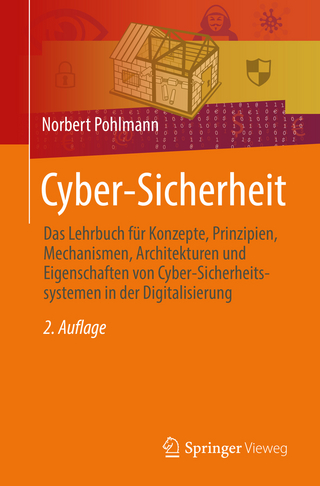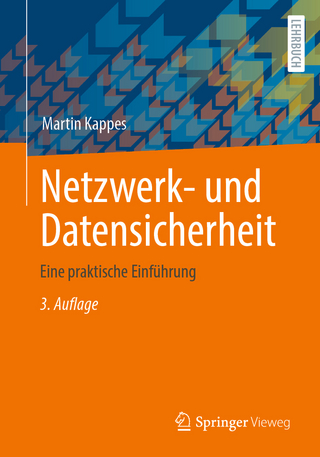
Network Security Empowered by Artificial Intelligence
Springer International Publishing (Verlag)
978-3-031-53509-3 (ISBN)
- Noch nicht erschienen - erscheint am 07.08.2024
- Versandkostenfrei innerhalb Deutschlands
- Auch auf Rechnung
- Verfügbarkeit in der Filiale vor Ort prüfen
- Artikel merken
This book introduces cutting-edge methods on security in spectrum management, mobile networks and next-generation wireless networks in the era of artificial intelligence (AI) and machine learning (ML). This book includes four parts: (a) Architecture Innovations and Security in 5G Networks, (b) Security in Artificial Intelligence-enabled Intrusion Detection Systems. (c) Attack and Defense in Artificial Intelligence-enabled Wireless Systems, (d) Security in Network-enabled Applications. The first part discusses the architectural innovations and security challenges of 5G networks, highlighting novel network structures and strategies to counter vulnerabilities. The second part provides a comprehensive analysis of intrusion detection systems and the pivotal role of AI and machine learning in defense and vulnerability assessment. The third part focuses on wireless systems, where deep learning is explored to enhance wireless communication security. The final part broadens the scope, examining the applications of these emerging technologies in network-enabled fields.
The advancement of AI/ML has led to new opportunities for efficient tactical communication and network systems, but also new vulnerabilities. Along this direction, innovative AI-driven solutions, such as game-theoretic frameworks and zero-trust architectures are developed to strengthen defenses against sophisticated cyber threats. Adversarial training methods are adopted to augment this security further. Simultaneously, deep learning techniques are emerging as effective tools for securing wireless communications and improving intrusion detection systems. Additionally, distributed machine learning, exemplified by federated learning, is revolutionizing security model training. Moreover, the integration of AI into network security, especially in cyber-physical systems, demands careful consideration to ensure it aligns with the dynamics of these systems.
This book is valuable for academics, researchers, and students in AI/ML, network security, and related fields. It serves as a resource for those in computer networks, AI, ML, and data science, and can be used as a reference or secondary textbook.
Yingying (Jennifer) Chen is a Professor and Department Chair of Electrical and Computer Engineering (ECE) and Peter Cherasia Endowed Faculty Scholar at Rutgers University. She is the Associate Director of Wireless Information Network Laboratory (WINLAB). She also leads the Data Analysis and Information Security (DAISY) Lab. She is a Fellow of IEEE and a Fellow of National Academy of Inventors (NAI). She is also an ACM Distinguished Member. Her research interests include Applied Machine Learning in Mobile Computing and Sensing, Internet of Things (IoT), Security in AI/ML Systems, Smart Healthcare, and Deep Learning on Mobile Systems. She is a pioneer in RF/WiFi sensing, location systems, and mobile security. Before joining Rutgers, she was a tenured professor at Stevens Institute of Technology and had extensive industry experiences at Nokia (previously Lucent Technologies). She has published 3 books, 4 book chapters and 240+ journal articles and refereed conference papers. She is the recipient of seven Best Paper Awards in top ACM and IEEE conferences. She is the recipient of NSF CAREER Award and Google Faculty Research Award. She received NJ Inventors Hall of Fame Innovator Award and is also the recipient of IEEE Region 1 Technological Innovation in Academic Award. Her research has been supported by many funding agencies including NSF, NIH, ARO, DoD and AFRL and reported in numerous media outlets including MIT Technology Review, CNN, Fox News Channel, Wall Street Journal, National Public Radio and IEEE Spectrum. She has been serving/served on the editorial boards of IEEE Transactions on Mobile Computing (TMC), IEEE Transactions on Wireless Communications (TWireless), IEEE/ACM Transactions on Networking (ToN) and ACM Transactions on Privacy and Security.
Jie Wu is Laura H. Carnell Professor at Temple University and the Director of the Center for Networked Computing (CNC). He served as Chair of the Department of Computer and Information Sciences from the summer of 2009 to the summer of 2016 and Associate Vice Provost for International Affairs from the fall of 2015 to the summer of 2017. Prior to joining Temple University, he was a program director at the National Science Foundation and was a distinguished professor at Florida Atlantic University, where he received his Ph.D. in 1989. His current research interests include mobile computing and wireless networks, routing protocols, network trust and security, distributed algorithms, applied machine learning, and cloud computing. Dr. Wu regularly published in scholarly journals, conference proceedings, and books. He serves on several editorial boards, including IEEE Transactions on Service Computing, IEEE/ACM Transactions on Networking, and Journal of Computer Science and Technology. Dr. Wu is/was general chair/co-chair for IEEE DCOSS'09, IEEE ICDCS'13, ICPP'16, IEEE CNS'16, WiOpt'21, ICDCN'22, IEEE IPDPS'23, and ACM MobiHoc'23 as well as program chair/cochair for IEEE MASS'04, IEEE INFOCOM'11, CCF CNCC'13, and ICCCN'20. He was an IEEE Computer Society Distinguished Visitor, ACM Distinguished Speaker, and chair for the IEEE Technical Committee on Distributed Processing (TCDP). Dr. Wu is a Fellow of the AAAS and a Fellow of the IEEE.
Dr. Cliff Wang graduated from North Carolina State University with a PhD in computer engineering in 1996. He has been carrying out research in the area of computer vision, medical imaging, high speed networks, and most recently information security. He has authored 60 technical papers and 3 Internet standards RFCs. Dr. Wang also authored/edited for 20 books in the area of information security and hold 4 US patents on information security system development. Since 2003, Dr. Wang has been managing extramural research portfolio and leading cyber security research at ARO and serves as the division director for Network Sciences. Since 2023, he is with NSF as program director and serves as the co-lead for the SaTC cl
Preface.- Part I. Architecture Innovations and Security in 5G Networks.- Chapter. 1. nCore: Clean Slate Next-G Mobile Core Network Architecture for Scalability and Low Latency.- Chapter. 2. Decision-Dominant Strategic Defense Against Lateral Movement for 5G Zero-Trust Multi-Domain Networks.- Part. II. Security in Artificial Intelligence-enabled Intrusion Detection Systems.- Chapter. 3. Artificial Intelligence and Machine Learning for Network Security - Quo Vadis?.- Chapter 4. Understanding the Ineffectiveness of the Transfer Attack in Intrusion Detection System.- Chapter. 5. Advanced ML/DL-based Intrusion Detection Systems for Software-Defined Networks.- Part III. Attack and Defense in Artificial Intelligence-enabled Wireless Systems.- Chapter. 6. Deep Learning for Robust and Secure Wireless Communications.- Chapter. 7. Universal Targeted Adversarial Attacks Against mmWave-based Human Activity Recognition.- Chapter. 8. AdversarialMachine Learning for Wireless Localization.- Chapter. 9. Localizing Spectrum Offenders Using Crowdsourcing.- Chapter. 10. Adversarial Online Reinforcement Learning Under Limited Defender Resources.- Part. IV. Security in Network-enabled Applications.- Chapter. 11. Security and Privacy of Augmented Reality Systems.- Chapter. 12. Securing Augmented Reality Applications.- Chapter. 13. On the Robustness of Image-based Malware Detection against Adversarial Attacks.- Chapter. 14. The Cost of Privacy: A Comprehensive Analysis of the Security Issues in Federated Learning.- Chapter. 15. Lessons Learned and Future Directions for Security, Resilience and Artificial Intelligence in Cyber Physical Systems.
| Erscheint lt. Verlag | 7.8.2024 |
|---|---|
| Reihe/Serie | Advances in Information Security |
| Zusatzinfo | X, 405 p. 15 illus. |
| Verlagsort | Cham |
| Sprache | englisch |
| Maße | 155 x 235 mm |
| Themenwelt | Informatik ► Netzwerke ► Sicherheit / Firewall |
| Informatik ► Theorie / Studium ► Künstliche Intelligenz / Robotik | |
| Schlagworte | 5G Network • Adversarial Machine Learning • Artificial Intelligence • Computer Networks • convolutional neural networks • Crowdsourcing • Cyber-Physical Systems • cybersecurity • Deep learning • distributed Information-centric architecture • federated learning • Generative Adversarial Network • Intrusion Detection • machine learning • malware detection • Meta-learning • Millimeter Wave • Reinforcement Learning • securing augmented reality • Software-Defined Networking (SDN) • transfer Attack • Wireless localization • Wireless Security • zero-trust architecture |
| ISBN-10 | 3-031-53509-X / 303153509X |
| ISBN-13 | 978-3-031-53509-3 / 9783031535093 |
| Zustand | Neuware |
| Haben Sie eine Frage zum Produkt? |
aus dem Bereich


